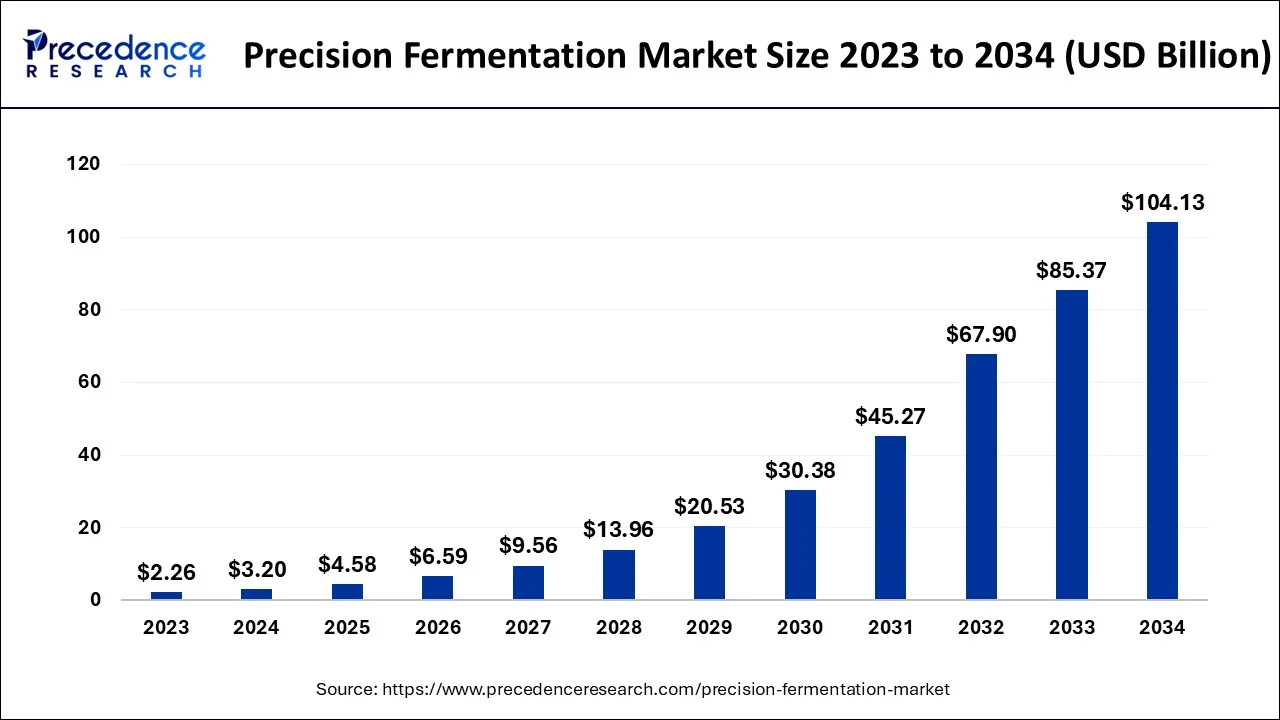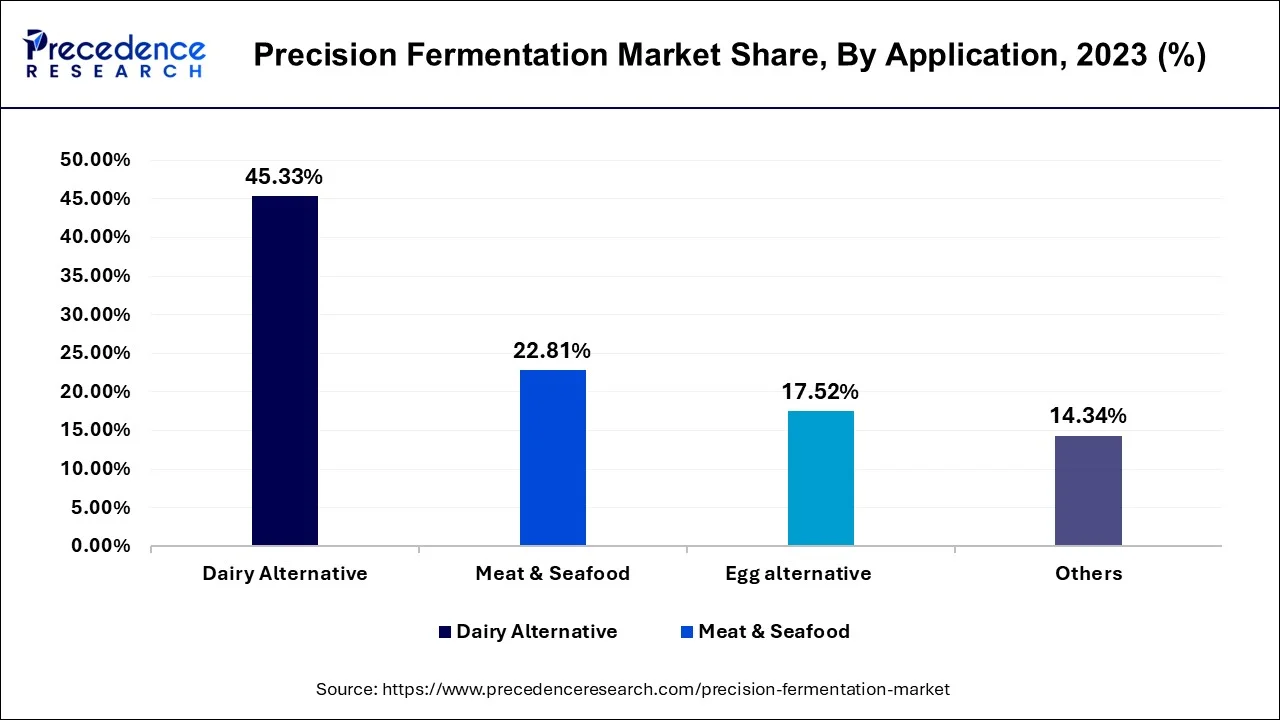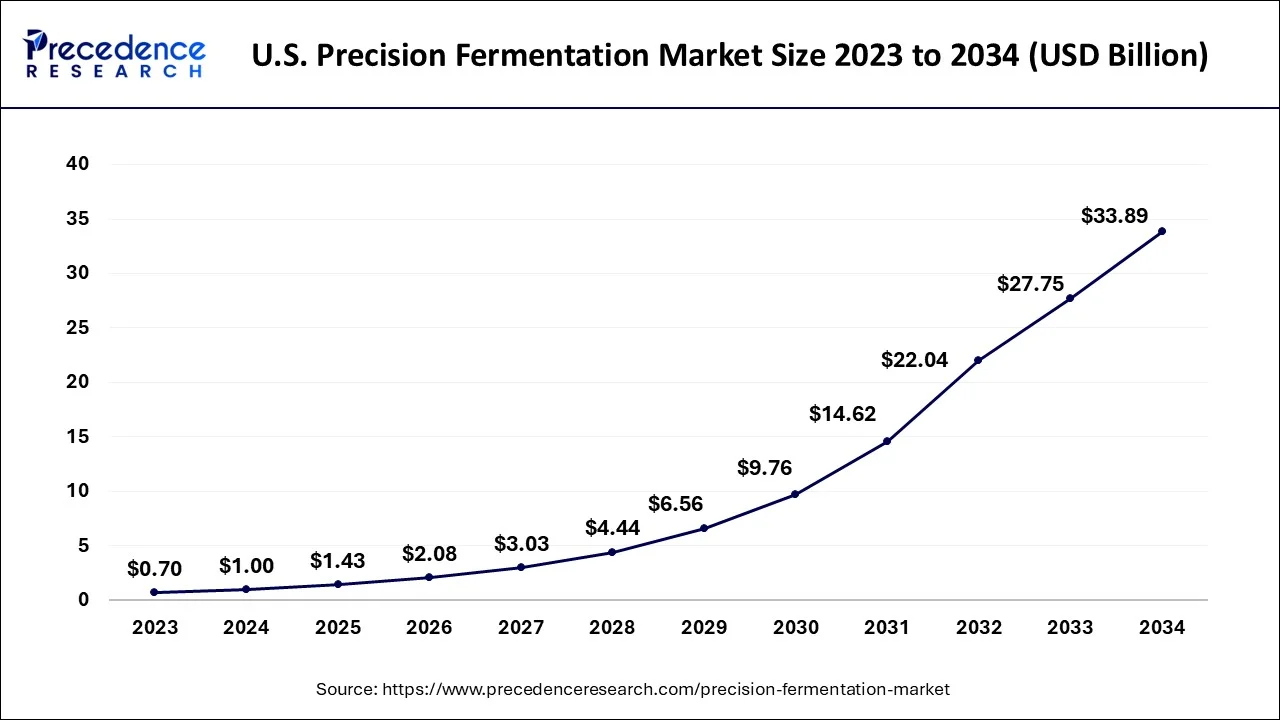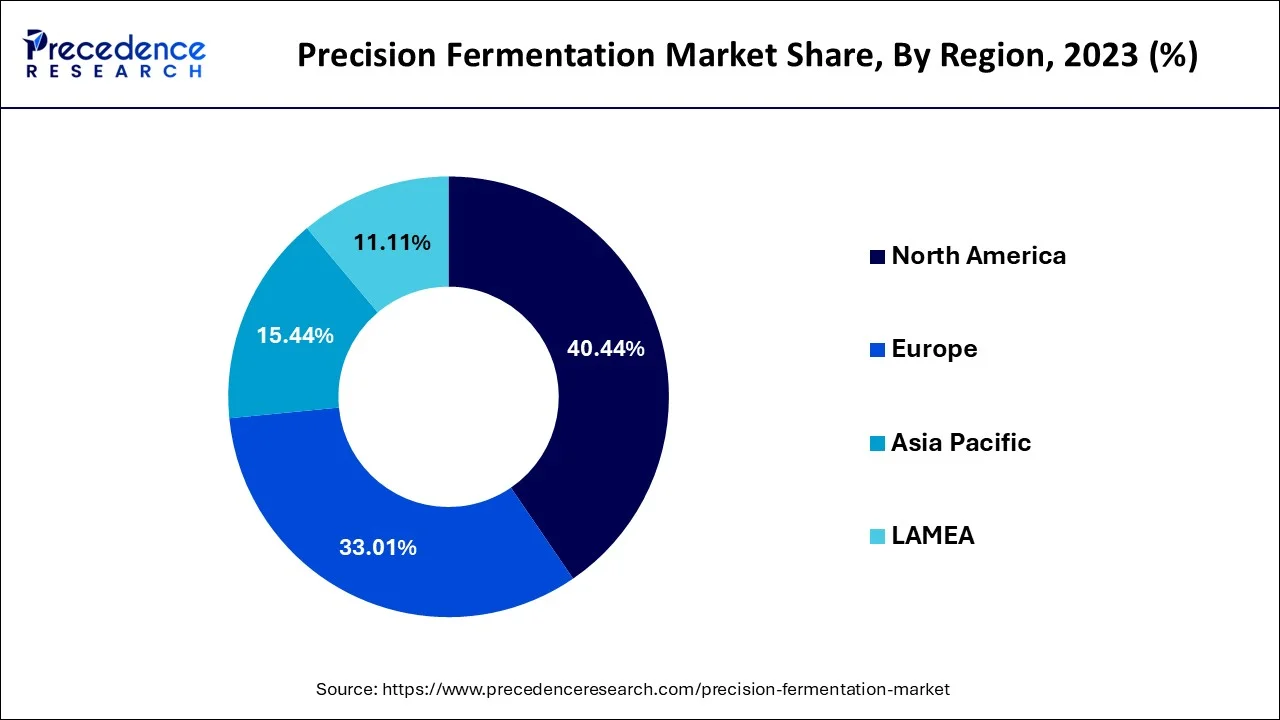List of Contents
What is the Precision Fermentation Market Size?
The global precision fermentation market size is estimated at USD 4.58 billion in 2025 and is anticipated to reach around USD 104.13 billion by 2034, growing at soild CAGR of 46% between 2025 and 2034.

Market Highlights
- North America holds the largest market share of 40.44% in 2025.
- By Application, the dairy alternative segment contributed more than 58.65% of revenue share in 2025.
- By Ingredient, the whey & casein protein segment has held a revenue share of 40% in 2025.
- By Microbe, the yeast segment contributed the highest market share between 2025 and 2034.
- By fermentation type, the biomass fermentation segment contributed more than 51.47% of revenue share in 2025.
Market Size and Forecast
- Market Size in 2025: USD 4.58 Billion
- Market Size in 2026: USD 6.59 Billion
- Forecasted Market Size by 2034: USD 104.13 Billion
- CAGR (2025-2034): 46%
- Largest Market in 2024: North America
- Fastest Growing Market: Asia Pacific
Market Overview
Precision fermentation refers to using microorganisms, such as bacteria, fungi, and yeast, to produce various products, including food, beverages, and pharmaceuticals. This technology involves using advanced biotechnology tools, such as genetic engineering, to design and optimize microbial strains for specific applications.
The precision fermentation market has gained significant attention, primarily due to its potential to address several sustainability and health-related issues. For example, precision fermentation can help reduce the environmental footprint of traditional agriculture by producing food and beverages without the need for large amounts of water, land, and other resources. Additionally, precision fermentation can be used to produce plant-based proteins that are more sustainable and healthier than animal-derived proteins.
Furthermore, the global precision fermentation market is anticipated to grow considerably, driven by the increasing demand for sustainable and healthy food and beverages. The industry is also expected to be a major growth driver as companies seek to development of new products that cater to varying consumer preferences. For instance, several startups use precision fermentation to produce meat alternatives, such as lab-grown meat, with a lower environmental impact than traditional meat products.
The pharmaceutical industry is also expected to be a significant market for precision fermentation. This technology can be used to produce a variety of drugs and other therapeutics, including vaccines, antibodies, and enzymes. Precision fermentation can also help reduce the cost and time required for drug development and production, making it an attractive option for pharmaceutical companies. However, regulatory hurdles and consumer acceptance are anticipated to impede market growth.
The use of precision fermentation involves genetic engineering and other advanced biotechnologies, which may be subject to strict regulations in some countries. Regulatory hurdles can slow down the development and commercialization of precision fermentation products. Also, the initial cost of setting up precision fermentation facilities can be high, and scaling up production can be complex. This may limit the adoption of precision fermentation, particularly by smaller companies.
Market Scope
| Report Coverage | Details |
| Market Size in 2025 | USD 4.58 Billion |
| Market Size in 2025 | USD 6.59 Billion |
| Market Size by 2034 | USD 104.13 Billion |
| Growth Rate from 2025 to 2034 | CAGR of 46% |
| Largest Market | North America |
| Base Year | 2025 |
| Forecast Period | 2024 to 2034 |
| Segments Covered | Application, Ingredient, Microbe, Fermentation Type, and Region |
| Regions Covered | North America, Europe, Asia-Pacific, Latin America and Middle East & Africa |
Market Dynamics
Drivers
Sustainable and environmentally friendly production methods to brighten the market prospect
Precision fermentation is an innovative technology that involves microorganisms such as yeast and bacteria to produce a wide range of products, including food, cosmetics, and pharmaceuticals. It is an environmentally friendly and sustainable alternative to traditional production methods that rely on resource-intensive processes such as agriculture and animal husbandry. It also allows the production of products with fewer greenhouse gas emissions than traditional production methods. This makes precision fermentation a more sustainable and environmentally friendly option.
Furthermore, the precision fermentation market is driven by consumers' growing demand for sustainable and eco-friendly products due to increasing awareness about the negative impact of traditional production methods on the environment, including deforestation, greenhouse gas emissions, and water pollution. In addition, the increasing demand for alternative protein sources is another factor driving demand for the precision fermentation market.
As the world's population continues to grow, there is a need for more sustainable and efficient ways to produce protein. Precision fermentation offers a way to produce protein-rich products, such as meat substitutes, without the need for animal agriculture. Thus, the growing precision fermentation market increased the demand for environmentally friendly and sustainable production methods.
Increasing consumer awareness of health and wellness
Consumers are becoming more & more health conscious and seeking out products perceived as healthier and better for them. Precision fermentation offers several health benefits over traditional production methods. For instance, it allows for producing products with reduced sugar, salt, and fat levels, all associated with health concerns such as obesity, heart disease, and diabetes. It can also produce probiotics, beneficial bacteria that promote digestive health and boost the immune system.
Furthermore, precision fermentation can be used to produce plant-based products that are high in nutrients and beneficial compounds such as antioxidants. These products are often perceived as healthier than traditional animal-based products, which can be high in saturated fat and cholesterol.
The increasing demand for plant-based products is also driving the growth of the precision fermentation market. Plant-based diets have several health benefits, including a lessened risk of chronic diseases such as cancer and heart disease. Precision fermentation allows for producing plant-based products high in protein, such as meat substitutes, without the need for animal agriculture. Thus, the growing awareness of health and wellness among consumers is driving the growth of the precision fermentation market.
Key Market Challenges
The limited range of the light electric vehicle is causing hindrances to the market
There is growing interest in sustainable and environmentally friendly products, but some consumers may hesitate to try new products that are produced using precision fermentation technology. Precision fermentation is a relatively new technology, and many consumers may not be familiar with it. Consumers may be wary of products that are produced using microorganisms and may have concerns about the safety and quality of these products. Furthermore, some consumers may be attached to traditional production methods and unwilling to switch to alternative products, even if they are more sustainable and environmentally friendly. This could be particularly true in agriculture and animal husbandry, where traditional methods have established supply chains and consumer preferences.
To overcome these challenges, companies operating in the precision fermentation market will need to focus on educating consumers about the benefits of the technology and building trust in the safety and quality of their products. This could involve working with regulators to establish clear safety and quality standards for precision fermentation products and investing in marketing and advertising campaigns to raise consumer awareness.
Companies must also focus on developing precision fermentation products that meet consumer preferences and taste expectations. This could involve working with food scientists to develop new and innovative products that appeal to consumers and conducting taste tests and consumer surveys to gather feedback and make improvements.
Opportunities
Precision fermentation produces a wide range of alternative protein sources
Precision fermentation has the potential to revolutionize the food industry by producing a wide range of alternative protein sources. This technology can be used to produce animal-free proteins that have the same nutritional value and sensory properties as traditional animal-based proteins. This offers an opportunity to address the growing demand for protein, while also addressing environmental concerns and animal welfare issues.
In addition, precision fermentation offers an opportunity to produce a wide range of alternative protein sources that are sustainable, nutritious, and cost-effective. The growing demand for sustainable proteins, health and nutrition concerns, technological advancements, and regulatory support are all key factors driving the growth of the alternative protein market.
Biomedical applications for precision fermentation
precision fermentation offers great opportunities for biomedical applications, including the production of therapeutic proteins, vaccines, personalized medicine, and drug discovery. The technology has the potential to revolutionize the field of medicine, offering new treatments and therapies for a wide range of diseases and medical conditions. In addition, rising demand for biologics, advancements in biotechnology, the need for rapid and efficient production, growing environmental concern, and rising government support are some of the factors indicating lucrative growth opportunities in the precision fermentation market.
Segments Insights
Application Insights
On the basis of application, the precision fermentation market is divided into meat & seafood, dairy alternatives, egg alternatives, and others, with the meat & seafood segment accounting for most of the market. This is because precision fermentation produces plant-based meat substitutes, cultured meat, and seafood alternatives. These products can potentially disrupt the traditional animal agriculture industry and meet the growing demand for sustainable and healthy protein sources. Thus, further driving demand for meat & seafood in the application segment.

The meat and seafood segment of the precision fermentation market is driven by the need for sustainability, improved nutrition, cost-effectiveness, and animal welfare. The application of precision fermentation techniques in the meat and seafood industry has the potential to revolutionize the way animal-based proteins are produced, leading to a more sustainable and environmentally friendly food system.
Precision Fermentation Market Revenue, By Application, 2022-2024 (USD Million)
| By Application | 2022 | 2023 | 2024 |
| Meat and Seafood | 363.9 | 514.7 | 733.3 |
| Dairy Alternative | 722.2 | 1,022.7 | 1,458.6 |
| Egg alternative | 277.8 | 395.3 | 566.5 |
| Others | 236.1 | 323.2 | 3,203.5 |
Ingredient Insights
On the basis of the ingredient, the precision fermentation market is divided into whey & casein protein, egg white, collagen protein, heme protein, enzymes, and others, with the whey & casein protein accounting for most of the market. This is because whey protein is a highly popular dietary supplement used by athletes, fitness enthusiasts, and others looking to improve their health and fitness. It is a rich source of vital amino acids and is known to support muscle growth and repair. Precision fermentation enables the production of high-quality whey protein more sustainably and cost-effectively than traditional methods and further creates demand for the precision fermentation market. Prominent driving factors for the growth of the whey and casein segment of the precision fermentation market include rising demand for dairy alternatives, health and nutrition, technological advancements, and increasing regulatory support.
Precision Fermentation Market Revenue, By Ingredient, 2022-2024 (USD Million)
| By Ingredient | 2022 | 2023 | 2024 |
| Whey & Casein Protein | 575.4 | 814.8 | 1,162.2 |
| Egg White | 341.9 | 485.1 | 693.1 |
| Collagen Protein | 404.4 | 572.2 | 815.2 |
| Heme Protein | 278.3 | 383.9 | 533.1 |
Microbe Insights
On the basis of microbe, the precision fermentation market is divided into yeast, algae, fungi, and bacteria, with the bacteria accounting for most of the market because it can optimize the growth and production of specific strains of yeast that are tailored to different applications. For instance, precision fermentation can produce yeast strains optimized for beer production, resulting in a more consistent and high-quality product. Similarly, precision fermentation can be used to produce yeast strains that are optimized for bread production, resulting in a more efficient and sustainable process. The bacteria-based precision fermentation market is driven by the increasing demand for sustainable products, advances in genetic engineering, cost-effectiveness, and regulatory support.
Precision Fermentation Market Revenue, By Microbe, 2022-2024 (USD Million)
| By Microbe | 2022 | 2023 | 2024 |
| Yeast | 486.9 | 689.8 | 984.1 |
| Algae | 413.1 | 584.1 | 831.7 |
| Fungi | 379.7 | 538.4 | 768.7 |
| Bacteria | 320.3 | 443.7 | 619.0 |
Regional Insights
U.S. Precision Fermentation Market Size and Growth 2025 to 2034
The U.S. precision fermentation market size accounted for USD 1.43 billion in 2025 and is predicted to be worth around USD 33.89 billion by 2034, expanding at CAGR of 46.70% between 2025 and 2034.

North America dominates the market, primarily driven by the increasing demand for sustainable and plant-based products in the region. The market can be divided into the United States and Canada, with the United States being the largest market in the region. Furthermore, increasing demand for plant-based meat substitutes in the region. Also, dairy alternatives are growing rapidly, driven by the rising demand for cheese, plant-based milk, and other dairy products.
Europe is a significant market for precision fermentation, with Germany, the United Kingdom, and France being the major contributors to the market's growth. Increasing demand for sustainable and alternative protein sources. Europe's precision fermentation allows for the production of proteins without the need for large-scale animal farming, which is a key contributor to greenhouse gas emissions and other environmental problems. As consumers in the region become more aware of the effect of their food choices on the environment, the demand for sustainable protein sources is expected to increase and further boost demand for precision fermentation in Europe.

The region in Asia-Pacific is anticipated to have the greatest CAGR. This growth is primarily driven by the growing demand for sustainable and eco-friendly products, increasing investments in R&D, and the rising awareness of the health benefits of plant-based foods. The Asia-Pacific region has some of the world's largest population centers, which drive demand for food and beverage products. In addition, the region is witnessing a shift in consumer preferences towards healthy and natural products, which is further driving the growth of the precision fermentation market.
Precision Fermentation Market Companies
- Change Foods
- Geltor, Helania Inc
- Formo
- FUMI Ingredients
- Fybraworks Foods
- Imagindairy Ltd
- Eden Brew
- Impossible Foods Inc
- Melt & Marble
- Motif Foodworks, Inc
- Mycorena, Myco Technology
- New Culture
- Nourish Ingredients
- Perfect Day Inc
- Remilk Ltd
- Shiru Inc
- The Every Co.
- Triton Algae Innovations
Recent Developments
- In November 2024, The Food and Beverage Accelerator (FaBA) based at The University of Queensland released precision fermentation to strengthen food systems and boost food security.
- In May 2024, Bored Cow, a leader in animal-free dairy industry, announced its expansion into 2,000 Albertsons stores in New York to provide dairy products made through precision fermentation.
Segments Covered in the Report
By Application
- Meat & Seafood
- Dairy Alternatives
- Egg Alternatives
- Others
By Ingredient
- Whey & Casein Protein
- Egg White
- Collagen Protein
- Heme Protein
- Enzymes
- Others
By Microbe
- Yeast
- Algae
- Fungi
- Bacteria
By Fermentation Type
- Precision Fermentation
- Biomass Fermentation
- Traditional Fermentation
By Region
- North America
- Europe
- Asia-Pacific
- Latin America
- Middle East and Africa
For inquiries regarding discounts, bulk purchases, or customization requests, please contact us at sales@precedenceresearch.com
Frequently Asked Questions
Ask For Sample
No cookie-cutter, only authentic analysis – take the 1st step to become a Precedence Research client